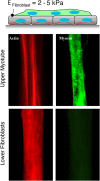Myotubes differentiate optimally on substrates with tissue-like stiffness: pathological implications for soft or stiff microenvironments
- PMID: 15364962
- PMCID: PMC2172122
- DOI: 10.1083/jcb.200405004
Myotubes differentiate optimally on substrates with tissue-like stiffness: pathological implications for soft or stiff microenvironments
Abstract
Contractile myocytes provide a test of the hypothesis that cells sense their mechanical as well as molecular microenvironment, altering expression, organization, and/or morphology accordingly. Here, myoblasts were cultured on collagen strips attached to glass or polymer gels of varied elasticity. Subsequent fusion into myotubes occurs independent of substrate flexibility. However, myosin/actin striations emerge later only on gels with stiffness typical of normal muscle (passive Young's modulus, E approximately 12 kPa). On glass and much softer or stiffer gels, including gels emulating stiff dystrophic muscle, cells do not striate. In addition, myotubes grown on top of a compliant bottom layer of glass-attached myotubes (but not softer fibroblasts) will striate, whereas the bottom cells will only assemble stress fibers and vinculin-rich adhesions. Unlike sarcomere formation, adhesion strength increases monotonically versus substrate stiffness with strongest adhesion on glass. These findings have major implications for in vivo introduction of stem cells into diseased or damaged striated muscle of altered mechanical composition.
Figures









References
-
- Bates, M.A., and D. Frenkel. 2000. Phase behavior of two-dimensional hard rod fluids. J. Chem. Phys. 112:10034–10041.
-
- Borschel, G.H., R.G. Dennis, and W.M. Kuzon Jr. 2004. Contractile skeletal muscle tissue-engineered on an acellular scaffold. Plast. Reconstr. Surg. 113:595–602, discussion 603-604. - PubMed
-
- Bushell, G.R., C. Cahill, F.M. Clarke, C.T. Gibson, S. Myhra, and G.S. Watson. 1999. Imaging and force-distance analysis of human fibroblasts in vitro by atomic force microscopy. Cytometry. 36:254–264. - PubMed
Publication types
MeSH terms
Substances
LinkOut - more resources
Full Text Sources
Other Literature Sources

